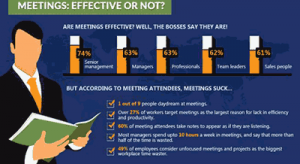There’s not a lot of love for meetings. They really do get a bad wrap.
So what if we were to introduce a few techniques to make them more productive, memorable and meaningful? That sounds like something worth exploring!
We really can’t (and shouldn’t) avoid meetings. We need them to discuss important issues, to make decisions, problem-solve, collaborate and move forwards.
So it’s time we put some of that negativity behind us, face our fear of meetings head on and take some action! Just before we do, let’s understand the scale of the problem we’re up against.
 This infographic from Lane End Conferences shares some interesting stats. According to their research, the average number of meetings attended by managers each month is 60 and ten percent of meetings held by UK companies last for more than 6 hours! In all that time spent, 47 percent of attendees felt that too many meetings was the biggest waste of their time.
This infographic from Lane End Conferences shares some interesting stats. According to their research, the average number of meetings attended by managers each month is 60 and ten percent of meetings held by UK companies last for more than 6 hours! In all that time spent, 47 percent of attendees felt that too many meetings was the biggest waste of their time.
We’ve all been to meetings that drag on while minds wander (apparently 60 percent of attendees take notes to look like they’re listening) and excuses mysteriously begin to crop up. On the other hand, there are those meetings that are bursting with energy and enthusiasm, generating fantastic ideas and leaving attendees feeling like the session was fun and productive.
So what’s the difference between a dull and sterile meeting and one that energises and inspires us? And what exactly constitutes a good meeting anyway?
Well, we’d probably all agree that a successful meeting generally includes the following elements:
- Efficiency– stuff gets done!
- Openness and honesty– people open up, share and say what they think
- Positivity and fun– attendees enjoy themselves and don’t fear future meetings
- Participation– everyone gets involved
- Creativity– different thinking takes place and new ideas are generated
For the purpose of this post (and because we’re massive fans of creativity) we’ll focus on that final point. We can improve meetings enormously by using a little creative forethought and planning things differently. Of course, the type of meeting you’re having will determine how flexible you can be, but ultimately we all have the choice to run better meetings. We just need to know how.
Here are 10 ideas to get the ball rolling:
SET THE SCENE
Open with positive stories. The way meetings start will set the tone for the whole session. Avoid kicking off with the latest troubles, complaints and problems. Try something new! In less that 30 seconds ask each attendee to share something positive, like:
- Something interesting you’ve learned since the last meeting
- Tell us about a person who has helped you in the last week
- Name one thing you’ve accomplished this week that’s made you feel proud
PROVIDE AN INSPIRING ENVIRONMENT
Create a fun atmosphere where everyone feels welcome, alert and up for it. Comfortable seating in a relaxed environment, preferably not around a boardroom table is a good place to start. Alternatively, get outside and try a walking meeting for a change.
If you’re staying indoors, music can often help as long as it doesn’t distract, along with appropriate lighting to make everyone feel more comfortable and present. You can also have snacks, drinks and creative extras available (an assortment of toys like Play-doh, Lego and stress balls always go down well too).
ENTERTAIN HUMOUR
Get the feel-good endorphins flowing. Enjoy a few minutes of amusing entertainment before you start. This video was shared recently by a friend on Twitter and started off our day brilliantly. It’s a hilarious example of how communication can be ‘misinterpreted’!
INTRODUCE NEW LEARNING TECHNIQUES
People love to learn new skills so try introducing a new technique or a brain-boosting warm up. For your meeting icebreaker, practice lateral thinking exercises as a group:
Try HEADLINES – it’s a simple process:
- Obtain 4 completely random words
- Write a newspaper headline that incorporates two of the words – you choose the situation.
Or RESCUE – a problem-solving exercise:
- Obtain 5 completely random words
- Use one of the random words to suggest a problem or crisis
- Use a different random word to suggest how the situation can be rescued
- Explain your thinking.
USE VIBRANT, ENGAGING VISUALS
“90 percent of information transmitted to the brain is visual and our brains process visuals 60,000 times faster than text.”
Strong and memorable visuals get everyone on the same page, picturing the big ideas.
Cut back on the chatter and try out some new tricks – hand out some big bold markers and use a magic whiteboard to capture thoughts or if budget allows, harness the power of visual thinking by inviting along a graphic facilitator.
GET MOVING!
NHS staff will soon be offered zumba and yoga in a bid to keep them fit and healthy and we could learn a thing or two from that. Our bodies don’t like sitting still for extended periods of time. We tend to get slow and lethargic and our brains follow suit. It’s time to get the blood flowing!
Try a few simple stretches at the start, after breaks or when people need a little lift:
- Get everyone on their feet
- Bounce for 10 seconds
- Stretch your arms up towards the ceiling
- Keeping arms up, lean over to the left
- Lean to the right, backwards and forwards
- Touch your toes
- And sit back down
Help those bodies and brains to feel a little more flexible and a lot more creative.
GUEST APPEARANCES
Invite people along who can offer a fresh perspective. Perhaps colleagues from different departments who may not otherwise have attended, suppliers, stakeholders or even clients, if appropriate. People who are removed from the day-to-day issues can be better at seeing the wood for the trees and may ignite different thought processes. They can help meetings to take unfamiliar routes, keeping them fresh and breaking new ground.
FIND THE WORST POSSIBLE IDEA
Discuss a specific issue and challenge attendees to compete for the most terrible idea. It’s a great way to break the ice and get a bit of laughter going. And quite often, the worst ideas can lead to surprisingly successful solutions…
PLAY THE ‘YES…AND…’ GAME
The yes…and… approach is a protocol that permits anything to happen. It allows for more openness and more possibilities, a perfect tone to set for meetings.
To trigger creativity, try playing “Yes… and….” to address a specific challenge. Each attendee offers a solution that is not to be judged by anyone else. Instead, team members develop the idea by saying, “Yes…and we could also….”
You’re not necessarily looking for practical solutions; this is an exercise in developing creative ideas. ‘But’ and ‘no’ are out of bounds.
CLOSE WITH A SPECIFIC CHALLENGE
Plan ahead and get the thoughts flowing in advance of your next meeting. Set a specific challenge at the end that colleagues can consider, discuss and deliberate in their own time. That way they’ll come along prepared and inspired to kick off your next meeting in a positive way!
And finally…
It is possible to reverse some of those sad statistics and restore our faith in meetings.
By taking a more positive and creative approach and introducing some different ideas to generate newfound energy, these sessions can be so much more productive.
It’s true that what works in one organisation may not be suitable for another, by trying out a few new techniques (the suggestion above are a good place to start) you’ll find what works best to get your people motivated and inspired.
We’d love to hear what’s working for you. Tweet us @alivewithideas with your success stories!

















